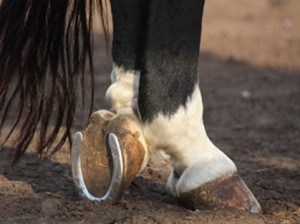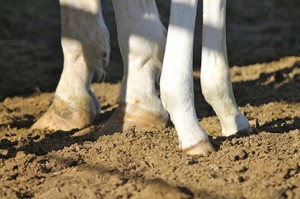Dealing With Hoof Cracks: Sole Supports for Health and Strength
By: Heather Smith-Thomas
Pat Burton, a Texas farrier, has developed effective ways to rehabilitate cracked feet, using management rather than bar shoes or other types of special shoeing. “Every day, the hoof grows and changes. My philosophy is to try to encourage good hoof growth and minimize anything that would inhibit that growth or put pressure on the affected site. We’re trying to repair damaged tissue, facilitate healing and regeneration, and prevent future fractures in the epidermal structures,” he explains.
In the past few years, Burton started using pour-in products as one way to develop parts of the foot that need to accept the load. “I use pour-in Vettec products and shape the material to the bottom of the foot so it still has some concavity and flexibility. That’s the key. It’s not a rigid substance. The foot must be able to move; we need to accommodate and manage that movement,” he says.
“I load the rest of the foot—which is the same premise behind putting on a bar shoe. But I do this with materials that mimic the sole or the hoof wall—like SuperFast, Sole Guard, and similar products. There’s also a new product that I tested for Vettec. Some products are very hard after they set, but this one still has some flexibility,” he says.
Material that’s too hard is not forgiving enough; it doesn’t flex with the foot and the hoof develops fracture lines. “This is one reason I leave the frog exposed when I pour material into the bottom of the foot. I pour it around the frog and mimic thickening of the sole. I find that horses working on proper footing will develop a stronger, thicker sole. I just try to encourage this with a pour-in. Sometimes I’ll do a second and third pour, but try to get away from this as soon as I can, and let the horse develop more sole on his own,” explains Burton.
“If the foot has 8 to 10-millimeter sole depth, and I pour another 4 millimeters, I’ve created 12 to 14-millimeters of protection—something that can handle the weight. If a sole becomes too thin, less than 8 millimeters, you’re in trouble. Some horses are ok with 10 millimeters and some are not. If you can get 12 to 15 millimeters of sole, those horses can walk on rocks and gravel and not get tender,” he says.
“When I pour the feet, I get an exact impression of the bottom of the foot. I’ve saved some of those. The first and second pour side-by-side may not be significantly different. But if you look at the first one and the third, or a later one, you can see how much change has occurred in increments over that time. There are changes in the dimension of the frog, changes in the heels, and in the depth of the digital cushion.”
These pours mimic what Nature wants to do with that foot—thicken and toughen it. “I consider it a synthetic sole that I’m pouring over the foot. I sculpt it out to retain some concavity and leave the frog exposed so it takes some weight and stimulates the foot to work properly,” says Burton.
The next pour is usually not as thick–just enough to help the horse keep moving around without becoming tender, because movement and exercise is the key to healing and stronger hoof development. This will help resolve the problem with cracks.
“If the horse doesn’t move and exercise, the foot won’t heal. If the horse is in pain, he isn’t going to move, and the foot won’t develop properly. Once it starts degenerating, it’s like a house of cards—it all starts to fall down. It starts atrophying. We need to go the other direction—and get the foot to start working again with stronger sole and hoof wall.”












